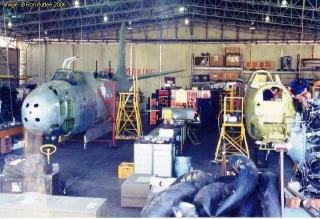Here are some images from the final stages of the Boston/Havoc restoration that occurred at No.23 Squadron RAAF Amberley in about 1995.
The aircraft on the left of this image (facing from the front of the hangar) is an A20G Havoc #42-86786 operated by the 388th BS/312th BG and recovered by the RAAF from near Annamoin Village (New Guinea) in Sept 1984.
The aircraft was lost on Sunday, 16th April 1944 (known as “Black Sunday” due to the number of aircraft losses that day). Both crew members were picked up by Royal Australian Navy stores carrier HMAS Matafele on 1 May 1944 in Madang Harbour after the crew made their way down the Gogol River. The Havoc was officially handed over to the Papua New Guinea Government in a ceremony on 12th September 1996 at the RAAF Amberley base. Second Lieutenant Charles Davidson who had piloted the aircraft on that fateful day attended the ceremony with his wife Thelma.
The A20G was the first mark of Havoc to introduce a solid nose housing four 20mm cannon, with the 2 standard Colt 0.5inch machine guns being retained in the lower nose. This increased the firepower of the aircraft, much needed for low level strafing missions in the Pacific Theatre. This particular aircraft is a block A-20G-20-D0 aircraft and introduced an electrically driven, manned Martin power turret equipped with two 0.50inch machine guns. The guns are actually fitted here, and can be seen in some of the views. The A20G was powered by two Wright Cyclone R-2600-23 14 cylinder twin row radial engines.
The aircraft on the right of the image above is an RAAF DB-7B Mark IIIa (the Havoc was known as the Boston in RAF/RAAF service). This specific aircraft was actually built by Boeing for Douglas, and was one of the first batch of 22 aircraft to be issued to the RAAF in March 1942, from RAF inventory. Originally ordered by the French, the aircraft was diverted to the RAF, given serial AL907 and given British markings. However before serving with the RAF, it was again reallocated to the Dutch for service in the Netherlands East Indies Airforce, and transferred to Java. It was once again diverted, this time to the RAAF when the Japanese invaded Java prior to delivery.
Serving with RAAF 22 Squadron out of Port Moresby, the aircraft had been issued with the serial A28-8 and was coded DU-J, and was nicknamed “J” for Jessica. The aircraft came to grief on December 12 1943. With damage to its hydraulics, and not being able to lower the undercarriage, it performed a wheels-up landing in a partly dry swamp at the end of the Goodenough runway. She had broken her back, and was subsequently written off.
The Boston was recovered by the RAAF in 1981, and returned to Australia for restoration. This began in 1983, first at RAAF Wagga Wagga (28 Squadron), and after several years there, the job was completed at Amberley also in 1996.
This Boston was one of those where the nose bombardier position was not used. It was painted over, and fixed .303in machine guns were installed for strafing.
Today this aircraft can viewed at the RAAF Museum at Point Cook Victoria.
Both these aircraft were ready for display on the celebration of the 50th Anniversary of VJ Day in Brisbane City Square in 1995, where I came across them again by accident.
The third hulk shown in the series (outside the hangar) was recovered for any spares or structural members they could use, and to check the structural fit and assembly of much of the airframe.



















